Archive for January, 2017
André Perugia: Patenting Celebrity

Andre Perugia is remembered as one of the first shoe designer and maker whose name reached celebrity. This is probably due to his revolutionary approach to shoe design, in between technical discipline and art-making, and also to the importance he gave to the idea of authorship, which led him to patent most of his ‘inventions’.
After having learned the technical skills from his father, Perugia set up his own boutiques, the first in Nice, his hometown, and then in Paris. His abilities as a maker developed working in an aircraft factory during the First World War. The precision needed in that sector opened up his mind to the possibility to apply ‘science’ to shoemaking; this made him halfway between a maker, an engineer and, of course, a master createur. During his long career, spanning from the 1920s to the 1960s, Perugia collaborated with the designers who ‘made’ history of fashion, from Paul Poiret to Elsa Schiaparelli and Christian Dior; he was also a collector of art, and many of his designs are hommages to his favourite artists, from Braques to Picasso. His last collaboration was with Charles Jourdan – he acted as consultant between 1960 and 1966 – to whom Perugia left his personal archive.
Perugia was a pioneer in giving value to his design by patenting his models. He is one of the first designers reflecting on his value as maker and above all inventor, reclaiming the authenticity of his products and establishing them as symbols of craft, quality, value and identity.
Apart from being a celebrity himself, Perugia also used other celebrities as inspirations to give form to his designs: in 1928, he turned Josephine Baker’s turban into the famous ‘Turban Sandal’. The link with celebrity culture is exeplified by the very title of his autobiography ‘From Eve to Rita Heyworth’, where he collects a number of psychological portraits, claiming that one way to understand women was to study their feet.
Face It: Celebrities on Clothes
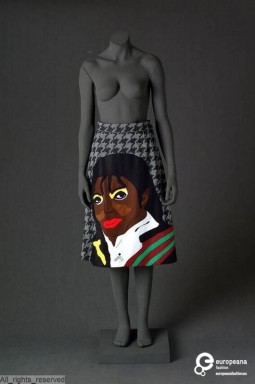
Before being creators, fashion designer are collectors. In their search for novelty and inspirations, they gather references and then dissect their findings, in search of what they need for their collection, purging them from the superfluous and un-interesting. In this process, not evens bodies are safe, as they get dismembered and severed, and sometimes just the heads live out to their designs.

Skirt with a portrait of Michael Jackson, designed by Bernhard Willhelm, 2000. Courtesy MoMu - ModeMuseum Provincie Antwerpen, all rights reserved.
In art, it was Andy Warhol who, in 1962, realized the famous diptych of silkscreens featuring the face of American diva Marilyn Monroe. The diptych, as part of a wider series of celebrities’ portraits, become itself iconic in respect to the work of the artist, and of Pop art and culture; it is still considered today an influential art piece for its multiplicity of meanings.

Bob Dylan on a poster dress designed by Harry Gordon - Poster Dresses Ltd, 1967. Courtesy Peloponnesian Folklore Foundation, all rights reserved.
It is reasonable to say that the same complexity of meanings and intentions invests the use of celebrities faces in fashion as well. Although sometimes just the features of certain celebrities, whether used as a print or as a decoration, can make fans sob and sigh, celebrities’ faces on clothes envision or enhance the concept of the collection and sometimes, they serve to embody the ideals of the brand.

'Kiki de Montparnasse', dress designed by Jean Paul Gaultier, f/w 1999-2000. Courtesy MUDE - Museu do Design e da Moda, all rights reserved.
More than collaborations, icons of the past and the latest stars are used to illustrate the narrative of the collections. Sometimes out of their contexts, these images gain new values or are used in antithetic circumstances to create new meanings or question others. Other times, they are tributes to a particular muse and in their most extreme and outspoken way they are shaped or constructed to resemble their most visible and memorable feature – their image.
Nudie Cohn: Embroidering the Cowboys

‘Nudie suits’ are as legendary as the celebrities who wore them. They are heavily customised bespoke suit, embroidered with rhinestones or studs in Western motifs, and bear the name of their creator, Nudie Cohn, an Ukranian-born tailor who bedazzled America with his bold creations.
Caravans and desert landscapes, bulls, cowboys riding horses in rodeos, poppies, marijuana, pheasants, eagles and other American birds are just some of the motifs ornating the designs by Nudie Cohn. An ode to the ‘Western’ American culture and its landmarks, these decorations found place on the famous suits, but also in dresses, suits, boots and hats that have been favoured by Country performers of the last century.

Shirt, designed by Nudie Cohn, ca. 1970-75. Courtesy MoMu - ModeMuseum Provincie Antwerpen, all rights reserved.
Born Nuta Kotlyarenko in 1902, Nudie got his later name when he moved to America with his family at the age of eleven to escape the Czarist pogroms. After working as shoe shiner in front of the Palace Theatre in Broadway, he became an itinerant boxer; it was during one of his travels that Nudie met his wife Helen Barbara Kruger, later Bobbie. Just married, they opened their first store in Manhattan in 1934. ‘Nudie’s for the Ladies’ sold lingerie and G-strings for starlets and burlesque dancers.

Suit, designed by Nudie Cohn, ca. 1970-80. Courtesy MoMu - ModeMuseum Provincie Antwerpen, all rights reserved.
But it was when Nudie and his wife moved to Hollywood that their business and above all his exuberant designs took off. Convinced that performers needed something more flamboyant to wear, Nudie designed the first embellished jackets in 1947. As the story goes, he made it after convincing the young and far from famous country musician Tex Williams to buy him a sewing machine. He had his first suits worn by another country star, Lefty Frizzel and after him, the success followed. Elvis Presley, Elton John, Dolly Parton, Roy Rogers, Cher, Gram Parsons were just some of the celebrities who attended his ‘Nudie’s of Hollywood’ and later ‘Nudie’s Rodeo Tailors’ shops.

Hat, designed by Nudie Cohn, ca. 1970-80. Courtesy MoMu - ModeMuseum Provincie Antwerpen, all rights reserved.
The activity run until 1994, with the help of Nudie’s wife and granddaughter after his death in 1984. A flamboyant character himself, the tailor used to drive customized promotional vehicles, Pontiacs decorated with the outrageous ornaments that he used to feature in his suits: bull’s horns, guns, saddles and silver dollar coins. Two of these cars have been collected by Belgian entertainer Bobbejaan Schoepen, who also owned a collections of suits and other garments by Cohn that has been put on show at MoMu in Antwerp from October 2011 to February 2012. The exhibition, curated by fashion historian Mari MacKenzie and designer R. Cerimagic, entitled ‘Dreamsuits. Designs by Nudie Cohn, the Rodeo Tailor’ was the first in Europe to explore the work of the tailor who embodied the style of the country music.
Piero Tosi: costume designer, icon-maker
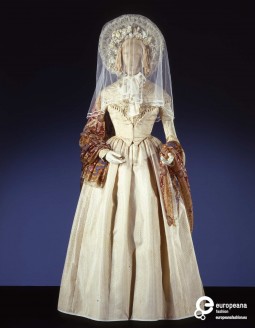
Piero Tosi is one of the most celebrated Italian costume designer. With his creations not only he greatly contributed to the image of the Golden Age of Italian cinema, developing costumes for movies whose style is one of the main features of their enduring fame.

Costume designed by Piero Tosi and worn by Isabelle Huppert in La Signora delle Camelie, by Mauro Bolognini, 1981, Courtesy Galleria del Costume di Palazzo Pitti, All Rights Reserved
Piero Tosi, born in 1927 in Sesto Fiorentino, near Florence, studied with painter Ottone Rosai. It was legendary director Luchino Visconti who gave him his first job in 1951, when Tosi moved from Florence to Rome to pursue a career in the movie industry. The collaboration with Visconti was one of the most fruitful of his career; together, they made: Bellissima, Senso, The Leopard, The Stranger, Death in Venice, Ludwig and The Innocent. Tosi did not stop to cinema; he also worked for the opera and theatre. In participating to this rich season for the movie industry – the season, we could argue, where icons were made primarily by their look on the screen – Tosi dressed actors as Romi Schneider, Laura Antonelli, Silvana Mangano, Anna Magnani. He also dressed Maria Callas for her role of Medeain the eponymous movie shot by Pier Paolo Pasolini in 1969.

Costume designed by Piero Tosi and worn by Maria Callas in Medea, by Pier Paolo Pasolini, 1969, Courtesy Galleria del Costume di Palazzo Pitti, All Rights Reserved
His talent consisted in materially building the vision each director had of the personages and their character. These ‘constructions’, imagined by the designer, were made in collaboration with Sartoria Tirelli, one of the most famous tailor shop in Rome, where most of the costumes for Cinecittà were produced.
Tosi has been nominated for the Academy Award for Costume Design five times: The Leopard, Death in Venice, Ludwig, La Cage aux Folles, La Traviata. He won both the David di Donatello for Best Costumes (La storia vera della signora delle Camelie and Storia di una capinera) and the BAFTA Award for Best Costume Design twice, as well as the 50th Anniversary David in 2006. In 2013 he was awarded an Academy Honorary Award For his personal achievements in costume design over 75 years of activity.

Costume designed by Piero Tosi and worn by Laura Antonelli in Il malato immaginario, by Tonino Cervi, 1979, Courtesy Galleria del Costume di Palazzo Pitti, All Rights Reserved
Today his designs are preserved in archives as material traces of a not so distant past we can hardly picture. His practice is historically located in a period in which the practice of costume design was harder, given the different access to information, both visual and conceptual, from the one we imagine today. His costumes bear the effort of representing a place, an era or a feeling and propose it to a public not only to make them dream, but also to tell them something relevant about the story and its context.
Europeana Fashion Focus: ‘Orgueil’ Perfume by Lucien Lelong, 1946
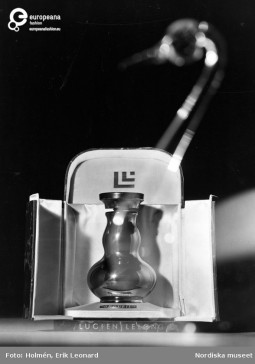
The perfume is a creation by French couturier Lucien Lelong. It was commercialised right after the end of WW2, and its name ‘orgueil’, meaning ‘pride‘ in French, was an homage to the endurance of the French population during the hard times of the war. The photo was taken by photographer Erik Leonard Holmén in 1947.
The perfume is described as an aldehydic fruity floral chypre fragrance with soft floral and spicy oriental undertones; in its bouquet, it is possible to distinguish plum, peach and sweet pea as top notes; carnation, tuberose, jasmine, iris, rose, cloves, nutmeg as middle notes; oak moss, sandalwood, ambergris and leather as base notes.
Lucien Lelong was born in Paris as the son of the owner of a textile shop. He studied at the Hautes Etudes de Commerciales and opened his fashion house in Paris in the early 1910s. Although he did not design his creations himself, he was able to gather a group of talented designers and support them in their first steps into the couture world: two people part of his network were, for example, Christian Dior and Pierre Balmain.
Lucien Lelong is credited with having done a great deal to preserve the couture industry in France during the difficult years of the Occupation, and this perfume stands as the celebration of the victory of perseverance in their democracy.
The object is part of Stiftelsen Nordiska Museet Archive.
Maria Callas: from Diva to Icon
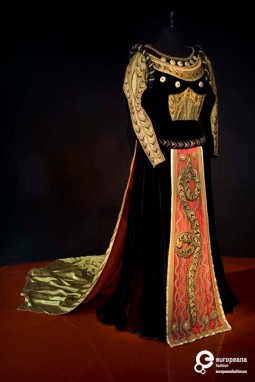
Maria Callas is internationally recognised as one of the most important ‘Divas’. Her popularity was motivated by her enormous talent, but surely her fashion choices, both on and off stage, weighed in her consecration as unforgettable icon.

Stage costume for Luigi Cherubini's Medea, designed by Lucien Coutaud, Courtesy Fondazione Cerratelli, All Rights Reserved
In her practice as opera singer, Maria Callas was indeed unique: an incredible interpreter, an innovator in her use of the voice, able to give unprecedented depth to the roles she took on. Her consecration on stage was enhanced by the costumes she wore, which were designed to suit her persona and immediately communicate with the audience. The costumes exemplified the encounter between the personality of the singer and the plot of the story on the body of callas, whose proverbial ability to convey emotions through her performance was in some way supported by the designs she wore. Clothes were something that she used as tools to get into the character and then made integral to the performance, accounting for them in the design of movements and gestures she designed to sew each role on herself.

Theatrical costume by Yannis Tsarouchis for Maria Callas in Medea, performed in Dallas, Texas, Courtesy Peloponnesian Folklore Foundation, All Rights Reserved
Her incredible talent was counterparted by a deep insecurity, which led her to be rather clumsy in her everyday life. Her appearance was not until 1951, when she made an encounter that changed her life. It was in that year that, in the Milanese home of director Arturo Toscanini, Maria Callas met Elvira Leonardi Bouyeure, better known as Biki. Biki was an established italian dressmaker at the time, whose atelier in Milan was a point of encounter for intellectuals and socialites. Biki not only did design all of Callas’ outfits, but actually re-styled the whole look of the singer, starting the transformation of Maria Callas from opera singer to international icon.

Cocktail ensemble in wool and silk designed by Biki, 1950s, Courtesy Galleria del Costume di Palazzo Pitti, All Rights Reserved
The relationship between Biki and Callas was well described by Hélène Blignaut in La scala di vetro (L’escalier de Verre), the biography of the designer. It is said that Biki used to provide the singer with written indications on how to compose each outfit, which were complete of accessories as hats and shoes. If Biki has contributed to the making of the ‘Diva’ Callas, the singer, in being one of the first ’testimonial’ of a brand, carried Biki’s design outside of Italy, establishing the name and fame of the designer across different places and, we can say today, across time as well.
A dress, a couturier and his muse
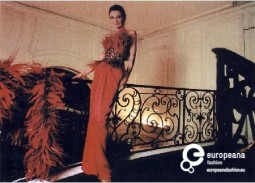
The relationship between Audrey Hepburn and Hubert de Givenchy is one of the greatest, enduring fashion pairings and friendships of all time which has generated the most iconic items of clothing in the history, looks that are still the epitome of style.
In 1954 Audrey Hepburn, who was working on the set of Sabrina, decided to go to the Paris atelier of master couturier Hubert de Givenchy to suggest a collaboration making her costumes for the film. Givenchy finally accepted to collaborate, contributing to create an iconic style for the character that made Audrey the highest-paid actress in the world. From this experience started a lifelong friendship based on mutual inspiration which reached the apogee of refined elegance. Las year Hubert de Givenchy has presented a book entitled “To Audrey with Love”, which contains designs for clothes he created for her on and off the screen.

Actress Audrey Hepburn wearing a red evening dress by Givenchy. 1989. Courtesy of CER.ES: Red Digital de Colecciones de museos de España. All rights reserved
The picture is a digital copy of a color photo in horizontal format with white frame. It represents actress Audrey Hepburn standing at the top of a staircase with the wrought iron railing and wearing a long red party costume designed by Givenchy. First appears the boa in ensemble with the dress. Audrey Hepburn worn the feather dress at the the Eighth Annual Council of Fashion Designers of America Awards on January 1989 at the Metropolitan Museum of Art in New York City.

Drawing of a woman wearing the very tight red evening dress by Hubert de Givenchy. 1989. Courtesy of CER.ES: Red Digital de Colecciones de museos de España. All rights reserved
The dress was originally designed by Givenchy for the actress Audrey Hepburn, who has been his muse since the 1960s. Here is the drawing of a woman wearing the very tight red evening dress. The body has neckline all made of feathers held in the center by a large bodice of red rhinestones. The outfit is completed by the red feather boa in ensemble.
Royal fashion affairs: Norman Hartnell
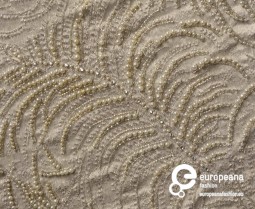
The name – and fame – of some designers is sometimes bound to that of their prestigious clients. Sir Norman Hartnell is one of them. In his more than fifty years of activity, the British designer had the honour to dress remarkable clients, but it is his his link to the British Royal family what made him gain a prominent role in the history of Western fashion.
Before beginning his career as a fashion designer opening a shop in London’s Mayfair in 1923, Sir Norman Hartnell had been the costume designer for the Footlights Dramatic Club of the University of Cambridge. It is this favour for the theatrical that characterised his own work, legible on his richly embroidered creations.

Dress designed by Norman Hartnell, produced by Berketex, ca.1942 - 1955. © Norman Hartnell for Berketex, Courtesy Victoria and Albert Museum, CC BY.
A prolific designer, Norman Hartnell has worked on women’s daywear, eveningwear and also homeware products, including a line that he designed for the British government utility campaign. It is, however, for the highly decorated gowns and dresses that he produced for his Royal clients that he is most remembered.

Wedding dress designed by Norman Hartnell, 1937. Courtesy Galleria del Costume di Palazzo Pitti, all rights reserved.
Although his first Royal commission was the wedding dress for the future Princess Alice, Duchess of Gloucester in 1935, Norman Hartnell gained the Royal Warrant as dressmaker to Queen Elizabeth The Queen Mother in 1940 and later to Queen Elizabeth II in 1957. For over three decades till his death 1979, he was appointed the design of the clothes that the two Queens have worn in public and private events, including the wedding dress of Princess Elizabeth for the marriage to Prince Philip in 1947 and her Coronation Dress six years later.
Both lavishly decorated, they exemplified the taste of the designed which said to ‘despise simplicity’. Reflecting the glaming allure of his clients, Normann Hartnell sticked to the sense of the spectacular that he seemed to have pursued since his early days as a costume designer: something that keeps defining his creations, worth princess and queens.
‘Past and Present’ and ‘Timeless Icons’: two exhibitions by Europeana Fashion at the Pop-Up Museum at the Netherland Institute for Sound and Vision

This January, The Netherlands Institute for Sound and Vision is the stage of a Pop-up Museum, an initiative of Europeana Space, themed around vintage fashion. This installation ties in with the current main exhibition at the museum, ‘Let’s YouTube’, which focuses on fashion and beauty themed videos. The display also showcases two video installation curated by the Europeana Fashion portal, featuring some of the amazing material it holds in its archive.
The Pop-up Museum is a product coming from the EU-funded project Europeana Space, which aims to create the technical and material space to foster re-use of cultural heritage in a new and innovative way. A hybrid of both a digital and physical museum exhibition, he Pop-Up Museum,is a way to showcase many of the prototypical ideas that have resulted from these pilots. The developers of Amsterdam-based IT company Noterik BV are partners of the project: they developed and co-created the possible interactions of users and digital material, and are now in the process of developing the back-end for the Pop-Up Museum and other exhibitions.

Naomi Campbell walking the Patrick Kelly autumn-winter 1989/1990 fashion show in Paris, Courtesy Paul Van Riel, All Rights Reserved
The Europeana fashion portal, thanks to the kind help of its partners and providers, has contributed with the curation of two video installations, developing two different themes: ‘Past and Present’ and ‘Timeless Icons’; the first focuses on the reinterpretation of the past by contemporary designers, putting images of historical garments alongside contemporary designs as seen on the latest catwalks; the second is about the relationship between celebrities and fashion, theme that we are developing in our blog this month, and that wants to unveil the fascinating link between fame, popularity, desire and fashion.
Stay tuned on Europeana Fashion and on the Netherlands Institute for Sound and Vision Website for more updates!
CELEBRITY (and) OBJECTS
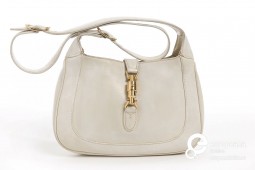
The history of fashion accounts for a number of emblematic accessories dedicated to celebrities; they often seem invested of some sort of magical power to retain the popularity of the person their name refers to – and in some cases exceed it.
Numerous are the example of objects whose creation was inspired by, or dedicated to celebrities; their stories do not cease to fascinate, enhancing their appeal as objects of everlasting desire. Not only objects, but also prints represent the relationship between brands and famous muses; this is the case of the ‘Flora’ print, made by Gucci especially for Grace Kelly during the 1960s.
Not always did these objects originate as an homage to the celebrity whose name they bear today; most times in fact, it was history itself that caused them to get renamed. This is the case for some of the most well-known bags, such as the infamous Kelly by Hermes, the Jackie O by Gucci and the Lady D by Dior. The Kelly bag originated at the end of nineteenth century as a large bag used for holding a saddle. It was thanks to Alfred Hitchcock and costume designer Edith Head that Grace Kelly was ‘introduced’ to the bag, and immediately fell in love with it. was photographed using the handbag to shield her growing belly from the paparazzi. When a photograph of the princess covering her belly was published on Life magazine in 1956, the bag instantly became known as the Kelly bag; however, it officially changed its name only in 1977.
The ‘Jackie O’’s original name was ‘Constance’, but the American first lady seemed to be so passionate about this bag, the fashion house officially dedicated the model to her. The Lady D was also renamed after the visit of Princess Diana to France in 1995. The bag was a present from Bernadette Chirac who wanted to gift the princess with a typically french design: she contacted the maison Dior and chose the Chouchou model, named which changed immediately after the princess of Wales was seen with the bag at the inauguration of the Cézanne exhibition at the Grand Palais.
Most of these iconic objects have been reinterpreted over and over again, in their design and materials, but always respecting their original shape, what made them iconic. When thinking about iconic accessories, one that comes straight to mind is the ‘Rainbow sandal’, created by Salvatore Ferragamo. Ferragamo himself used to say that the sandal was created for the actress Judy Garland, right after her appearance in the movie ‘The Wizard of Oz’, where she sings the emblematic song ‘Over The Rainbow’. The shoe, whose multicoloured wedge made it unforgettable, has been reinterpreted in 1988 by the Spanish fashion house ‘Menkes’, almost sticking accurately to the original design.
'Rainbow' Sandal, designed by Salvatore Ferragamo, 1938-1939, Courtesy Museo Salvatore Ferragamo, All Rights Reserved







